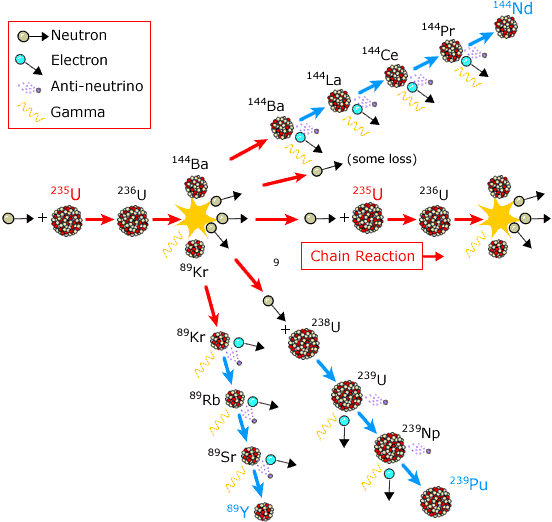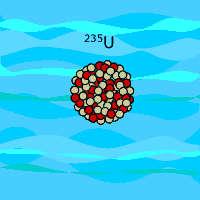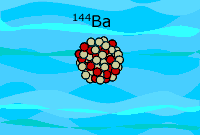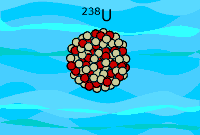|
The Fission Process in the Nuclear Reactor |
|

|
|
A neutron colliding with a 235U nucleus causes it to split into two nuclei (fission fragments, typically one heavier and one lighter nucleus) and several free neutrons (fission neutrons). The fission fragments, like 144Ba and 89Kr, have a very high velocity and disperse their kinetic energy into the closest environment, heating it up. 80% of the energy released in a fission process is carried by the fission fragments that are radioactive and decay fast.
|
Fission neutrons striking the next nuclei of uranium may start next fissions, and the next, and the next .... building up a chain reaction. Some neutrons are absorbed in the uranium isotope 238U which does not split. It captures a neutron becoming 239U, which after two beta decays becomes 239Pu. 239Pu is a long lived alpha-radioactive isotope.
|
235U |
||||||
|
 |
Fission, i.e. splitting of nuclei of heavy isotopes like 235U (or 239Pu) generates energy in a nuclear rector. A neutron collision with a heavy nucleus results in fission into two nuclei called fission fragments and into several neutrons. Fission products and fission neutrons have a very high velocity but slow down quickly producing heat. |
||||
144Ba |
||||||
|
 |
One of the most probable heavy fission fragments of 235U-fission is 144Ba (Barium). 144Ba is not stable, and similarly to its lighter companion 89Kr (Krypton), it beta-decays very fast, through consecutive emissions of electrons and anti-neutrinos to very, very long-lived 144Nd (Neodymium). |
||||
89Kr |
||||||
|
|
Fission fragments have masses around 90 and 140; most of them are radioactive. Decay of the fission fragments builds up a chain of other radioactive isotopes (fission products). As these processes continue also after the chain reaction in the reactor has stopped, some heat will continue to be produced after a reactor shutdown. |
||||
Plutonium Buildup |
||||||
|
 |
Plutonium isotopes, mainly 239Pu, are produced in reactor fuel when 238U absorbs a neutron and the resulting nucleus goes through two beta-decays. Part of the 239Pu is fissioned by neutrons directly in the reactor core, the rest remains in spent reactor fuel as toxic and unpleasant waste. It must therefore, be well isolated from the biosphere for a very long time. 239Pu can be used as a weapon material and therefore, must be under a strict control. Moreover, 239Pu can become a fuel for new types of reactors, like breeder reactors. It can even be reused in the existing reactors. This is a way to use the otherwise useless 238U for a long lasting energy production. |